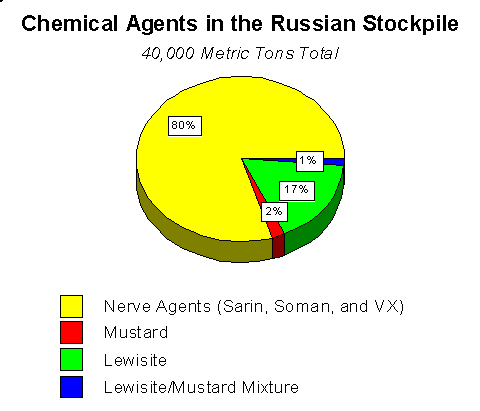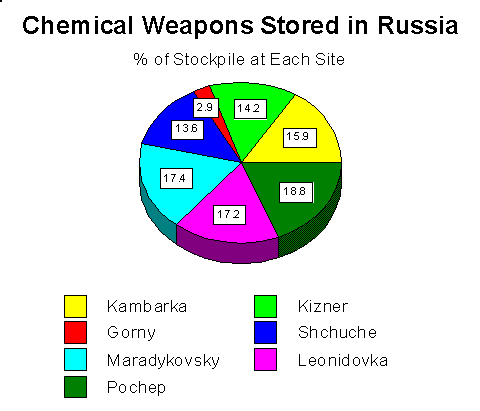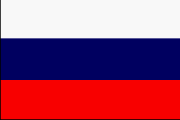Chemical Weapons
Many of the Soviet-era chemical and biological weapon programs date from an 17 August 1967 decree of the CPSU Central Committee and the USSR Council of Ministers, which directed preparations for chemical-biological war. This marked the beginnings of the secret "F" programs, which included the "Flute," "Fouette," and "Fagot" biological weapon programs, as well as the the "Flask," "Ferment," and "Factor" efforts. The "Flora" program was established by a 5 January 1973 decree of the CPSU Central Committee and the USSR Council of Ministers.The Russian Federation is the home of the former Soviet stockpile of chemical weapons � consisting of a declared stockpile of nearly 40,000 metric tons of chemical nerve, blister and choking agents. According to some reports, the total stockpile exceeds 50,000 tons, with an additional 32,300 ton stockpile of phosphorus agents.
During World War II, production of all types of chemical agents increased dramatically. Yperite alone was produced by 30 plants with a total capacity of 35,000 tons/year, and Lewisite was produced by 13 plants. Industrial production of sarin began in 1958-1959, production of soman began in 1967, and industrial production of V-agents began in 1972. In the early 1980's special storage facilities were built at industrial sites in Volgograd, Novocheboksarsk, Zaporozhye, Pavlodar, Volsk, and a number of other cities.
Production of chemical weapons was discontinued in Russia in 1987. Russia has officially stated its commitment to destroy, and not replace, its declared CW stocks. The Russian Duma, on December 27, 1996, passed a law on the destruction of CW; however, the Federation Council voted it down on January 23, 1997, on the grounds that it did not provide sufficient guarantees for ecological safety.
On 23 September 1989 Secretary of State James Baker and Soviet Foreign Minister Eduard Shevardnadze signed the Wyoming Memorandum of Understanding (MOU), which called for a bilateral exchange of information and verification inspections for chemical weapons. Two phases comprise the Wyoming MOU.
Phase I consisted of a data exchange data pertaining to CW capabilities, including the aggregate quantity of CW, types of chemicals in CW, percentage of chemicals in munitions and storage containers, and locations of CW storage, production and destruction facilities. Moscow declared some 20 former chemical weapon production facilities and filling plants that were operational after January 1, 1946, including multiple buildings within the large chemical production complexes at Chapayevsk, Dzerzinsk, Volgograd, and Novocheboksarsk. Each side visited CW storage, production, destruction and industrial chemical production facilities from June-August 1990. Phase I concluded with expert visits during January-February 1991 to five U.S. and one Soviet facility.
Phase II, which began on January 14, 1994, consisted of a two-part data exchange on the respective country's chemical weapons (CW) program including stockpiles and facilities associated with the development, production and storage of CW and five inspections by each country of facilities declared under Phase II. The data exchanged was intended to serve not only Phase II purposes, but also to be an indicator of the two countries' approaches to data declarations under the Bilateral Destruction Agreement (BDA) and, in part, under the Chemical Weapons Convention (CWC). The data exchange occurred in April and May 1994 and the inspections began in August 1994 and ended in December 1994.
Russia failed to comply fully with the data declaration provisions of the Wyoming MOU and its implementing procedures. Certain aspects of Russia's Phase II data on facilities, chemical agents, and stockpile were incomplete, inaccurate, or inconsistent with previously declared data. The on-site inspections originally agreed to under Phase II of the MOU were pared down in 1993. Russia refused to permit a full suite of technical inspection equipment, even after most inspections and all challenge inspections of non-declared sites were eliminated.
The program to destroy the Russian Federation�s chemical weapons stockpile faces many of the same challenges experienced by the United States. Both stockpiles are very large, are stored in multiple locations, and are comprised of a considerable variety of munition and agent types, as well as munition-agent combinations. In addition to these issues, Russian Federation laws that govern the chemical weapons destruction program dictate requirements the Russian program must meet. Consequently, the Russian Federation must take into account each of these factors and develop a destruction process that meets the specific conditions of its stockpile.
As detailed in Russian Federation Decree #305, On the Approval of the Special Federal Targeted Program for the Destruction of Chemical Weapons Stockpiles in the Russian Federation (21 March 1996), the Russian chemical weapons destruction support program has the following objectives:
- Destroy the stockpile in accordance with the Chemical Weapons Convention,
- Improve the ecological conditions of the areas surrounding chemical weapons storage and destruction sites, and
- Mitigate public concerns about living in close proximity to the storage locations.
To meet these objectives, the Russian program�s major priorities are to develop the social infrastructure in the areas surrounding the destruction facilities, ensure that the destruction process is conducted safely, protect and support recovery of the local environment, and make effective use of funding from all sources. Both Decree #305 and a subsequent law adopted on November 5, 1997, ratifying the Chemical Weapons Convention demonstrate the Russian Federation�s commitment to destroy its stockpile of chemical weapons by making provisions for allocation of funds to support the program and by designating the government officials and agencies responsible for accomplishing the program.
In October 1991, Vil S. Mirzayanov, a chemist who had worked for more than 25 years in the Soviet CW program, alleged that Moscow had developed a series of new and extremely lethal "third generation" nerve agents under a secret program code-named Foliant. His assertions were confirmed by two other scientists, Lev A. Fedorov and Vladimir Uglev. It was also claimed that Russia was working on developing new binary chemical warfare agents under the designation Novichok ["New Guy"]. Mirzayanov alleged that Russia intended to test and produce binary chemical weapons after ratification of the Chemical Weapons Convention. He was jailed in 1992 and 1993, though the US protested his arrest and the case against him was dismissed. After the Mirzayanov scandal, this work was officially reported to be suspended. Approximately 80 percent of the Russian stockpile is nerve agent. The specific agents in the Russian Federation stockpile are Sarin (GB), Soman (GD) and viscous Soman, Mustard (H), Lewisite (L), Mustard-Lewisite mixture, Phosgene, and Russian VX. Russian VX, generally referred to as R-VX, is similar to the U.S. variant, but has some structural differences in its formula. Additionally, unlike the VX in the U.S. stockpile, R-VX occurs in both thickened (viscous) and non-thickened varieties, requiring the destruction process to address both types effectively.

The agents are stored in a variety of munitions and containers: projectiles, bombs, rocket warheads, missile warheads, spray tanks and bulk containers. The Russian stockpile of R-VX, Sarin, Soman and Phosgene is 100 percent weaponized, while the Mustard, Lewisite and Mustard-Lewisite mixture are stored primarily in large bulk containers (similar to, but much larger than, the one-ton storage containers in the U.S. stockpile). With the exception of "complex" munitions, none of the Russian chemical weapons contain explosive components. The welded construction of the Russian munitions makes it impossible to use the reverse-assembly technology developed in the United States. Consequently, the Russian Federation needed to develop a different destruction approach than that adopted in the United States. Also, due to the lack of explosive components in the majority of these weapons, the selected Russian destruction technology does not need to include deactivation as a step in the process.
Of the seven locations where these agents are stockpiled, five store nerve agents � Shchuch�ye, Kizner, Pochep, Leonidovka and Maradykovsky. The remaining sites, Kambarka and Gorny, primarily store blister agent. The facility at Shchuch�ye also stores Phosgene. The chemical weapons stored at each installation are categorized by the branch of the military service that commands the installation. The Air Force-controlled installations (Pochep, Leonidovka and Maradykovsky) contain primarily air-delivered weapons. The storage locations, as well as Kizner and Shchuch�ye, are under the command of the Russian Ground Forces and contain primarily rocket and tube artillery warheads/projectiles. The Chemical and Biological Forces are responsible for Gorny and Kambarka, which only house blister agents in bulk containers. Russian officials have denied allegations that Russia possesses strategic missiles carrying multiple reentry vehicles loaded with chemical agents, or that Russia has the capability to deliver chemical agents using strategic bombers.
The Russian Chemical Weapons Destruction Program
The program to destroy the Russian Federation's chemical weapons stockpile faces many of the same challenges experienced by the United States. Both stockpiles are very large, are stored in multiple locations, and are comprised of a considerable variety of munition and agent types, as well as munition-agent combinations. In addition to these issues, Russian Federation laws that govern the chemical weapons destruction program dictate requirements the Russian program must meet. Consequently, the Russian Federation must take into account each of these factors and develop a destruction process that meets the specific conditions of its stockpile.
The Former Soviet Union built a large factory in Chapayevsk for chemical destruction of chemical agents using ethylene glycol and ethanol amine - good solubilizers and strong nucleophiles to attack and chemically transform the agents. This methodology had the disadvantage that large amounts of liquid waste remain for subsequent disposal. The plant became operational in 1989, but was closed almost immediately because of public opposition.
In 1993 the Russians decided to destroy chemical weapons at their storage locations because of public resistance to their transport. They estimated that seven plants are needed and would operate in two stages using chemical neutralization followed by incineration or processing to useful products.
The Russians have also proposed chemical neutralization of agents followed by incineration or processing to useful products. Russian scientists have investigated the chemistry of mustard agent to produce thiodiglycol, metal adsorbents, and rubber. This strategy of recycling chemical agents into valuable products has obvious appeal. The Russians have announced that a plant in Novocheboksarsk that previously produced chemical weapons and now produces fertilizers and other products for civilian industry may be used to destroy chemical weapons while continuing their civilian output. This policy is clearly different from that in the U.S. where demilitarization and civilian industry are kept strictly separate and there are no plans for conversion of chemical agents to useful products.
Russians examined alternatives for treatments of Lewisite: chlorination, catalytic hydrogenation, and alkali hydrolysis. It appeared that hydrolysis followed by electrolysis to arsenic had the most promise. Mixtures of mustard and Lewisite may be neutralized in sulfur melts. Recipes for neutralization of organophosphorus agents are: monoethanolamine (at 100 to 140 oC) for Sarin and Soman, a mixture of ethylene glycol and ortho-phosphoric acid for VX. The Russians have studied a fluidized bed reactor; the bed is alumina impregnated with Cr, Fe and operates between 450 - 650 oC without formation of CO or NOx. Other, long term possibilities may be irradiation or volcanic magma. Biological methods may be useful for final clean-up of waste products. Russian workers have also explored catalytic decomposition of agents directly in the munition case.
Engineering development of chambers to contain explosions is well developed in Russia. Their experience shows that 2 kg of explosive requires a chamber with diameter of 1.4 m, 15 kg requires 4.5 m. Destruction of 5 kg of chemical agent requires 25 kg of explosive; the corresponding equipment weight, including the chamber, is 50 tons. This chamber technology appears to be highly adaptable to the problem of disposal of explosively configured chemical munitions, enabling the destruction of the munition without contaminating the surrounding area and may answer the difficult problem of disposal of unstable, explosively configured weapons in a populated area. The Design and Technology Institute of High Rate Hydrodynamics in Novosibirsk has considerable experience in design and construction of explosion containing chambers.
In Russia, chemical agents have generally been stored separated from explosives. Russia has developed a mobile unit for chemical neutralization followed by incineration for destruction of faulty munitions (without explosives). This unit has been used in a Russian city and is considered by Russia to be environmentally safe. It is reported to handle up to 90 kg/hr of agent and, during the period 1980 - 1990, destroyed more than 4000 munitions containing a total of 200 tons of Sarin, Soman, or VX. Further development is in process to enable processing of chemical neutralization products into useful materials, e.g., for treatment of timber.
States, including Germany, The Netherlands, Sweden, Italy, and the U.S., have offered assistance to destroy the Russian stockpile by providing specialized laboratories, equipment, and training. Currently the Russians, cooperating with the US, are evaluating a two step process for destruction of nerve agents: 1) chemical neutralization of the agent, 2) immobilizing the neutralization products in bitumen and disposal in landfill. For GB and GD the process uses monoethanolamine in water at 110 0C for neutralization, followed by addition to bitumen and calcium hydroxide and heating at 200 0C and a reduced pressure of 0.1 atm for one hour. The strong base, calcium hydroxide, aids in neutralization reactions and binds the fluoride ions from the agents as insoluble calcium fluoride. For VX, the process uses a Russian decontaminating solution, RD-4 (N-methyl pyrolidinone, potassium isobutylate, isobutyl alcohol), followed by treatment with bitumen at elevated temperature and reduced pressure. Tests indicate that the phosphorus containing neutralization products are bound in the bitumen and that this mixture is greatly reduced in toxicity. Based on testing reported through the summer of 1996, the Russian two step process effectively and irreversibly destroys nerve agents. The long term stability of the bitumen mixture and its suitability for land fill are being investigated. It appears that this method is based on previous Russian studies for chemical weapon decontamination and demilitarization (using monoethanolamine and RD-4) and on the availability and relatively low cost of the binding material - bitumen.
As detailed in Russian Federation Decree #305, On the Approval of the Special Federal Targeted Program for the Destruction of Chemical Weapons Stockpiles in the Russian Federation (21 March 1996), the Russian chemical weapons destruction support program has the following objectives:
- Destroy the stockpile in accordance with the Chemical Weapons Convention,
- Improve the ecological conditions of the areas surrounding chemical weapons storage and destruction sites, and
- Mitigate public concerns about living in close proximity to the storage locations.
To meet these objectives, the Russian program's major priorities are to develop the social infrastructure in the areas surrounding the destruction facilities, ensure that the destruction process is conducted safely, protect and support recovery of the local environment, and make effective use of funding from all sources. Both Decree #305 and a subsequent law adopted on November 5, 1997, ratifying the Chemical Weapons Convention demonstrate the Russian Federation's commitment to destroy its stockpile of chemical weapons by making provisions for allocation of funds to support the program and by designating the government officials and agencies responsible for accomplishing the program.
Sources and Resources
- Chemical Weapons in Russia: History, Ecology, Politics [Khimicheskoye Oruzhiye V Rossii: Istoriya, Ekologiya, Politika ] by Doctor of Chemical Sciences Lev Aleksandrovich Fedorov Moscow Center of Ecological Policy of Russia 1994 [27 July 1994] analysis of the chemical weapons problem in Russia as a nation-wide political and ecological problem
- UNDECLARED CHEMICAL WAR IN RUSSIA, Lev Fyodorov, Union for Chemical Safety (Russia)


